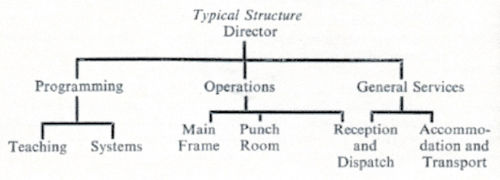Department of Computation
a note by A J Willmott
The review of the computing facilities available in about 1965 to Universities and other research organisations, undertaken by the Flowers Committee, (“A Report of a Joint Working Group for Computers for Research", January 1966, Cmnd. 2883.) revealed there were a number of problems, not least was the capacity of the British computer manufacturers to deliver to the Universities the computers required on the scale proposed by the Flowers Committee.
It just so happened that in 1966, I was working as a Lecturer in the Department of Computation at UMIST. The Head of my Department was the late Professor Gordon Black who was also a member of the Flowers Committee. He had drawn up a table on paper, the columns of which were allocated to each of the computer manufacturers, in particular, ICT, English Electric and Elliotts. The emphasis was on British companies. When the work of that committee was over and the report had been published and presented to Parliament, Professor Black gave me that table. On that table for York was entered Elliott 4130. The choice appeared to be made upon the size of the University (small in 1966) and the capacity of Elliotts to deliver the number of machines required throughout the UK. Sadly, I destroyed this piece of paper when I moved to York as the first lecturer in Computation there. However, I was not surprised to find an Elliott 4130 computer installed in a splendid computer building in a suitable air conditioned environment!
(While still at Manchester, I went to hear a lecture given by Professor Flowers about the preparation of the Flowers Report. There was one memorable remark which he made in which he commented that he had insisted that quite a number of the meetings of the Flowers Committee take place in his office in the Department of Physics at the University of Manchester. Some of the civil servants had complained about this to which he had replied, "It is no further from London to Manchester than it is from Manchester to London!")
The Flowers Committee were very much aware that some universities had little experience in providing a computer service and they suggested that, typically, such a department might be structured as indicated in the diagram below in Figure 1.

Figure 1
Whether the University of York authorities were aware of this suggestion by the Flowers Committee is unknown. Be it sufficient to say that the structure of the department as I found it when I arrived at York in March 1968 as the first Lecturer in Computation here, was very much along the lines of Figure 1. The Director was David G Burnett-Hall. Staff had been appointed and were in place as operators of the "main frame" (to use the Flowers terminology) and there was at least one punch card machine operator. The "Reception and Dispatch" (of computer programs run on the 4130) was handled by the computer operators. Some little while after I had been in place at York, Peter J. Roberts was appointed as 'Computer Manager' as head of "Operations". The "Programming" section was filled by one or two programmers, including Sinikka Wyatt. The department relied on the computer manufacturer to supply "Systems" support.
Not fitting into this department structure was a commercial systems analyst and programmer in the person of the late David Hardcastle. He was responsible for developing systems and programs for the processing of university "commercial data". He had an office in the Computation building although much later, he was moved to an office in Heslington Hall. It was David who showed me round the campus when I first arrived.
Somehow, I seemed to fit into the "Teaching" part of the Flowers department structure. Certainly I found myself helping computer users to debug their programs, including Professor Michael Woolfson of Physics to whom I had provided similar support at UMIST when he was the Reader in Physics there!
Now the diagram started to disintegrate as Dr Ron Thomas, who followed me from UMIST, arrived in September/October 1968 to become the second lecturer to be appointed. Moreover, plans were already in hand when I had arrived to set up a combined degree course with Mathematics, with Computation as the subsidiary subject. This course began in October 1969.
With [the] arrival of Dr Ian C Wand from IBM in mid-February 1972, a new structure for the department started to emerge. All three of us, RJT, ICW and I were active in research: ICW (Languages and Software) with RJT and myself (Numerical Applications). The university authorities were aware of all this, especially with the appointment of W (Bill) Freeman as a Research Fellow. He became a Lecturer later, needless to say.
The Flowers department structure certainly did not include a strong academic element and this method of department operation just did not work very effectively. With all this in mind, the Vice Chancellor, the late Lord James, set up a committee to review the running of the department when he became aware of the conflicts of interests between the academic and the computing service requirements that existed. This committee recommended that while the office of Director (now of what today we would call the Computer Service) should remain, in addition there should be appointed a Professor and new Head of Department.
These recommendations were accepted and, in due course, Professor Ian C Pyle was appointed as the new Head of Department in 1974 or thereabouts. It was Professor Pyle who insisted that the department be renamed Computer Science and that he be called the Professor of Computer Science. David Burnett- Hall remained Director. This provided a significant turning of the fortunes of the department. Indeed, subsequently, the Computer Service was separated from the academic department with its own Director and David Burnett-Hall assuming the position of Reader (a status he had held when he became Director of Computation when he was first appointed) within the Computer Science Department.